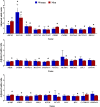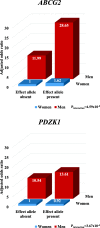Interactions between serum urate-associated genetic variants and sex on gout risk: analysis of the UK Biobank
- PMID: 30626429
- PMCID: PMC6327586
- DOI: 10.1186/s13075-018-1787-5
Interactions between serum urate-associated genetic variants and sex on gout risk: analysis of the UK Biobank
Abstract
Background: Sex-specific differences in the effect of genetic variants on serum urate levels have been described. The aim of this study was to systematically examine whether serum urate-associated genetic variants differ in their influence on gout risk in men and women.
Methods: This research was conducted using the UK Biobank Resource. Thirty single nucleotide polymorphisms (SNPs) associated with serum urate were tested for their association with gout in men and women of European ancestry, aged 40-69 years. Gene-sex interactions for gout risk were analysed using an interaction analysis in logistic regression models.
Results: Gout was present in 6768 (4.1%) men and 574 (0.3%) women, with an odds ratio (95% confidence interval) for men 13.42 (12.32-14.62) compared with women. In men, experiment-wide association with gout was observed for 21 of the 30 serum urate-associated SNPs tested, and in women for three of the 30 SNPs. Evidence for gene-sex interaction was observed for ABCG2 (rs2231142) and PDZK1 (rs1471633), with the interaction in ABCG2 driven by an amplified effect in men and in PDZK1 by an absence of effect in women. Similar findings were observed in a sensitivity analysis which excluded pre-menopausal women. For the other SNPs tested, no significant gene-sex interactions were observed.
Conclusions: In a large population of European ancestry, ABCG2 and PDZK1 gene-sex interactions exist for gout risk, with the serum urate-raising alleles exerting a greater influence on gout risk in men than in women. In contrast, other serum urate-associated genetic variants do not demonstrate significant gene-sex interactions for gout risk.
Keywords: Genetics; Gout; Urate.
Conflict of interest statement
Ethics approval and consent to participate
UK Biobank obtained approval from the North West Multi-Centre Research Ethics Committee (11/NW/0382). Full written informed consent was obtained from all participants prior to the study.
Consent for publication
Not applicable.
Competing interests
TRM has received consulting fees or grants from Ardea Biosciences and AstraZeneca. ND has received consulting fees, speaker fees, or grants from AstraZeneca/Ironwood, Kowa, Horizon, Amgen, Abbvie, and Janssen. The remaining authors declare that they have no competing interests.
Publisher’s Note
Springer Nature remains neutral with regard to jurisdictional claims in published maps and institutional affiliations.
Figures



References
-
- Akizuki S. A population study of hyperuricaemia and gout in Japan—analysis of sex, age and occupational differences in thirty-four thousand people living in Nagano Prefecture. Ryumachi. 1982;22(3):201–208. - PubMed
Publication types
MeSH terms
Substances
Grants and funding
LinkOut - more resources
Full Text Sources
Medical

